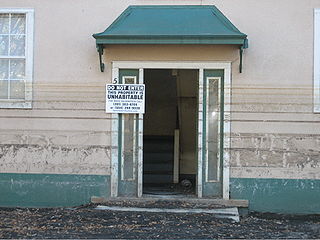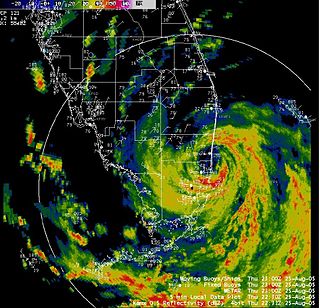
The Federal Emergency Management Agency (FEMA) is an agency of the United States Department of Homeland Security (DHS), initially created under President Jimmy Carter by Presidential Reorganization Plan No. 3 of 1978 and implemented by two Executive Orders on April 1, 1979. The agency's primary purpose is to coordinate the response to a disaster that has occurred in the United States and that overwhelms the resources of local and state authorities. The governor of the state in which the disaster occurs must declare a state of emergency and formally request from the President that FEMA and the federal government respond to the disaster. The only exception to the state's gubernatorial declaration requirement occurs when an emergency or disaster takes place on federal property or to a federal asset—for example, the 1995 bombing of the Alfred P. Murrah Federal Building in Oklahoma City, Oklahoma, or the Space Shuttle Columbia in the 2003 return-flight disaster.

Hurricane Katrina was a destructive Category 5 Atlantic hurricane that caused over 1,800 fatalities and $125 billion in damage in late August 2005, especially in the city of New Orleans and the surrounding areas. It was at the time the costliest tropical cyclone on record and is now tied with 2017's Hurricane Harvey. The storm was the twelfth tropical cyclone, the fifth hurricane, and the third major hurricane of the 2005 Atlantic hurricane season, as well as the fourth-most intense Atlantic hurricane on record to make landfall in the contiguous United States.

The disaster recovery response to Hurricane Katrina in late 2005 included U.S. federal government agencies such as the Federal Emergency Management Agency (FEMA), the United States Coast Guard (USCG), state and local-level agencies, federal and National Guard soldiers, non-governmental organizations, charities, and private individuals. Tens of thousands of volunteers and troops responded or were deployed to the disaster; most in the affected area but also throughout the U.S. at shelters set up in at least 19 states.

Hurricane Katrina's winds and storm surge reached the Mississippi coastline on the morning of August 29, 2005. beginning a two-day path of destruction through central Mississippi; by 10 a.m. CDT on August 29, 2005, the eye of Katrina began traveling up the entire state, only slowing from hurricane-force winds at Meridian near 7 p.m. and entering Tennessee as a tropical storm. Many coastal towns of Mississippi had already been obliterated, in a single night. Hurricane-force winds reached coastal Mississippi by 2 a.m. and lasted over 17 hours, spawning 11 tornadoes and a 28-foot storm surge flooding 6–12 miles (10–19 km) inland. Many, unable to evacuate, survived by climbing to attics or rooftops, or swimming to higher buildings and trees. The worst property damage from Katrina occurred in coastal Mississippi, where all towns flooded over 90% in hours, and waves destroyed many historic buildings, with others gutted to the 3rd story. Afterward, 238 people died in Mississippi, and all counties in Mississippi were declared disaster areas, 49 for full federal assistance. Regulations were changed later for emergency centers and casinos. The emergency command centers were moved higher because all 3 coastal centers flooded at 30 ft (9 m) above sea level. Casinos were allowed on land rather than limited to floating casino barges as in 2005.

The reconstruction of New Orleans refers to the rebuilding process endured by the city of New Orleans after Hurricane Katrina destroyed much of the city on August 29, 2005. The storm caused levees to fail, releasing tens of billions of gallons of water. The levee failure contributed to extensive flooding in the New Orleans area and surrounding parishes. About 80% of all structures in Orleans Parish sustained water damage. Over 204,000 homes were damaged or destroyed, and more than 800,000 citizens displaced—the greatest displacement in the United States since the Dust Bowl of the 1930s. Wind damage was less severe than predicted. The damage that took place that needed to be repaired cost about $125 billion.

This article contains a historical timeline of the events of Hurricane Katrina on August 23–30, 2005 and its aftermath.

In September 2005, units of the Mexican Armed Forces responded to the emergency situations after Hurricane Katrina with aid and assistance, appearing as a flagged, uniformed force in the United States for the first time since World War II in the 1940s and the first operational deployment of Mexican troops to the U.S. in 159 years.

Though Hurricane Katrina did not deal the city of New Orleans a direct hit on August 29, 2005, the associated storm surge precipitated catastrophic failures of the levees and flood walls. The Mississippi River Gulf Outlet ("MR-GO") breached its levees in approximately 15 places. The major levee breaches in the city include the 17th Street Canal levee, the London Avenue Canal, and the wide, navigable Industrial Canal, which left approximately 80% of the city flooded.

The Lower Ninth Ward is a neighborhood in the city of New Orleans, Louisiana. As the name implies, it is part of the 9th Ward of New Orleans. The Lower Ninth Ward is often thought of as the entire area within New Orleans downriver of the Industrial Canal; however, the City Planning Commission divides this area into the Lower Ninth Ward and Holy Cross neighborhoods.
Environmental Quality Management, Inc. (EQM) is an environmental engineering and remediation company headquartered in Cincinnati, Ohio that has been active in providing environmental remediation support in response to terrorist attacks, the space shuttle disaster, superfund site cleanup, hazardous chemical spills and natural disasters.

Osborne Reef is an artificial reef off the coast of Fort Lauderdale, Florida. Originally constructed of concrete jacks, it was the subject of an ambitious expansion project utilizing old and discarded tires. The expansion ultimately failed, and the reef has come to be considered an environmental disaster—ultimately doing more harm than good in the coastal Florida waters.

The term FEMA trailer, or FEMA travel trailer, is the name commonly given by the United States Government to forms of temporary manufactured housing assigned to the victims of natural disaster by the Federal Emergency Management Agency (FEMA). Such trailers are intended to provide intermediate term shelter, functioning longer than tents which are often used for short-term shelter immediately following a disaster. FEMA trailers serve a similar function to the "earthquake shacks" erected to provide interim housing after the 1906 San Francisco earthquake.
DRC Emergency Services is a hurricane debris removal company headquartered in Mobile, Alabama.

The effects of Hurricane Katrina in Florida were in both the southern portion of the state and in the panhandle. After developing on August 23, Katrina made landfall near the border of Broward and Miami-Dade counties with 80 mph (130 km/h) winds on August 25. While it was crossing the state, the hurricane's convection was asymmetrical, primarily located to the south and east of the center. As a result, high rainfall totals occurred in the Miami area, peaking at 16.43 in (417 mm) in Perrine. The rains caused flooding, and the combination of rains and winds downed trees and power lines, leaving 1.45 million people without power. Damage in South Florida was estimated at $523 million (2005 USD), mostly as a result of crop damage. Further south, the hurricane spawned a tornado in the Florida Keys. In the island chain, Katrina caused heavy rainfall and gusty winds.
Servpro is a franchisor of fire and water cleanup and restoration franchises in the United States and Canada. The franchise system provides localized services as well as large-scale disaster recovery. It is headquartered in Gallatin, Tennessee.

Richard E. Constable III is an American lawyer who was the 16th Commissioner of the New Jersey Department of Community Affairs, serving from 2012 to 2015. A former Assistant US Attorney, he was also the Deputy Commissioner of the New Jersey Department of Labor and Workforce Development.
The Bass Enterprises Oil Spill was the largest in a series of oil spills that were caused by damage due to Hurricane Katrina in coastal industrial facilities. About 3.78 million gallons were spilled at the facility in Cox Bay, Louisiana, while an additional 461,000 gallons were spilled at the location in Point a la Hache, also in Louisiana.

All Hands and Hearts (AHAH) is a U.S. 501(c)3 nonprofit organization. The organization's current structure formed in late 2017, when two existing nonprofits, All Hands Volunteers and Happy Hearts Fund merged to become All Hands and Hearts. All Hands Volunteers was founded in September 2005 by philanthropist and businessman David Campbell to provide relief to residents in areas affected by natural disasters worldwide. Happy Hearts Fund, founded by philanthropist and supermodel, Petra Němcová, sought a similar goal, to help communities recover after a disaster event. All Hands and Hearts is based in Mattapoisett, Massachusetts.
Marc-Philip Ferzan is an attorney, currently serving as Senior Managing Director at Ankura Consulting Group. He was formerly the director of the Governor's Office of Recovery and Rebuilding, from November 2012 until resigning in July 2014. The position was created by New Jersey Governor Chris Christie after Hurricane Sandy in October 2012 to coordinate relief and recovery efforts in face of the effects of the storm on the state. After resigning, he became lecturer at the Frank Batten School of Leadership and Public Policy at the University of Virginia.
The 2004 Taylor Energy oil spill is an ongoing spill located in the Gulf of Mexico, around 11 miles (18 km) off the coast of the U.S. state of Louisiana. It is the result of the destruction of a Taylor Energy oil platform during Hurricane Ivan in 2004. It is the longest-running oil spill in U.S. history. It was first brought to public attention when contamination at the site was noticed in 2010 by those monitoring the nearby Deepwater Horizon oil spill. A report by the Associated Press in 2015 challenged the estimates of the extent of the leak originally given by the company and the U.S. Coast Guard (USCG), which were then revised to be around 1,000 times greater than initially reported.










